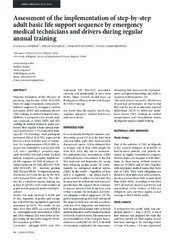Please use this identifier to cite or link to this item:
https://rfos.fon.bg.ac.rs/handle/123456789/1945Full metadata record
| DC Field | Value | Language |
|---|---|---|
| dc.creator | Andjelić, Sladjana | |
| dc.creator | Radojičić, Zoran | |
| dc.creator | Stojanović, Srđan | |
| dc.creator | Tamburkovski, Vlada | |
| dc.date.accessioned | 2023-05-12T11:22:08Z | - |
| dc.date.available | 2023-05-12T11:22:08Z | - |
| dc.date.issued | 2019 | |
| dc.identifier.issn | 1334-5605 | |
| dc.identifier.uri | https://rfos.fon.bg.ac.rs/handle/123456789/1945 | - |
| dc.description.abstract | Objective. Evaluation of the efficiency of practicing step-by-step (SBS) BLS/AED (basic life support/automatic external defibrillator) sequence by emergency medical technicians (EMT) and ambulance drivers (AD) working in medical transport teams. Methods. A prospective two-month study was conducted in which EMTs and ADs working in medical transport teams performed their regular 4-hour annual training (1 h of lectures, 1.5 h of practical training and 1.5 h of testing). Each participant performed SBS of BLS/AED sequences in front of a three-member team of instructors. The implementation of BLS/AED sequence was evaluated by scoring from 0 to 2 (0 - not, 1 - partially, 2 - properly), separately for EMI's, ADs and in total. The final analysis compared a properly implemented SBS sequence (S1-S36) of actions: IA initial assessment (S1-S10), BLS (S11-S18), AED (S19-S25), RP - recovery position (S26-532) and FBAO - foreign body airway obstruction (S33-S36) for use by the BLS/AED between EMTs and ADs. The criterion for a completed regular training was at least 47 (65.0%) of the total number of points won for properly implemented procedures. Results. The study involved 31 EMTs and 63 Ads, regardless of gender and average age, with EMTs having slightly longer work experience (p>0.05). The results of our study show that EMTs are more skilled at IA, cardiopulmonary resuscitation (CPR) and AED, whereas ADs were better at implementing RP and performing the Heimlich maneuver (p LT 0.001). Conclusion. Although EMTs and ADs implement SBS BLS/AED procedures correctly and satisfactorily in more than 65.0%, future research should focus on finding more efficient, shorter and cheaper BLS/AED trainings. | en |
| dc.publisher | Pharmamed Mado Ltd, Zagreb | |
| dc.rights | openAccess | |
| dc.rights.uri | https://creativecommons.org/licenses/by/4.0/ | |
| dc.source | Signa Vitae | |
| dc.subject | step-by-step | en |
| dc.subject | sequence | en |
| dc.subject | emergency medical technicians | en |
| dc.subject | basic life support | en |
| dc.subject | ambulance drivers | en |
| dc.title | Assessment of the implementation of step-by-step adult basic life support sequence by emergency medical technicians and drivers during regular annual training | en |
| dc.type | article | |
| dc.rights.license | BY | |
| dc.citation.epage | 21 | |
| dc.citation.issue | 1 | |
| dc.citation.other | 15(1): 14-21 | |
| dc.citation.rank | M23 | |
| dc.citation.spage | 14 | |
| dc.citation.volume | 15 | |
| dc.identifier.doi | 10.22514/SV151.042019.1 | |
| dc.identifier.fulltext | http://prototype2.rcub.bg.ac.rs/bitstream/id/576/1941.pdf | |
| dc.identifier.rcub | conv_2170 | |
| dc.identifier.scopus | 2-s2.0-85070474551 | |
| dc.identifier.wos | 000466443900001 | |
| dc.type.version | publishedVersion | |
| item.cerifentitytype | Publications | - |
| item.fulltext | With Fulltext | - |
| item.grantfulltext | open | - |
| item.openairetype | article | - |
| item.openairecristype | http://purl.org/coar/resource_type/c_18cf | - |
| Appears in Collections: | Radovi istraživača / Researchers’ publications | |
This item is licensed under a Creative Commons License


